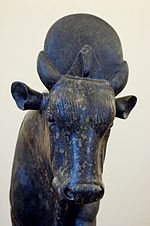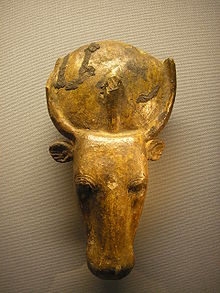Apis (Egyptian mythology)
| Apis in hieroglyphics | |||||||
|---|---|---|---|---|---|---|---|
| Old empire |
|
||||||
|
|||||||
| Middle realm |
|
||||||
|
|||||||
| New kingdom |
|
||||||
Hep Ḥp Hep |
|||||||
| Greek | Απις (Apis) | ||||||
| Sahidic Coptic | ϩ ⲁⲡⲉ (Hape) | ||||||
| Bohair Coptic table | ϩ ⲁⲡⲓ (Hapi) | ||||||
| Apis | |||||||
Apis ( ancient Egyptian Hep ; Coptic-Sahid Hape ; Coptic-Bohairian Hapi ; Aramaic ḥpy , חפי) was the Greek name of the sacred bull of Memphis , who was worshiped as the embodiment of the god Ptah .
meaning
Originally, the Apis bull was a symbol of fertility. He has been worshiped in the Temple of Ptah in Memphis since the First Dynasty . Later the Apis bull functioned as the “ herald ” of Ptah and became his “glorious soul”, who appears on earth in the form of the bull. The Apis bull was also considered an oracle .
Ancient writings tell of Apis that he spread terror, brought down smaller temples and even killed children and old people.
The Apis cult
The Apis bull had to die of natural causes, causing state mourning until a new bull was found that displayed the sacred signs. A red bull that was dedicated to Seth was then sacrificed to him . In the main cult site in Memphis, a new bull was then regularly housed so that the old bull could be sacrificed ( drowned in the Nile ). The body of the bull was mummified within 70 days and buried by priests of Ptah in the Serapeum of Saqqara . Before the 19th dynasty , burial took place in individual graves, afterwards and up to the Ptolemaic period in smaller or larger crypts.
The dead bull was identified with Osiris and worshiped as Osiris-Apis or Serapis .
presentation
The animal itself was black and had sacred symbols: a triangular white spot on the forehead and a white spot in the shape of a crescent moon on the right side. Since the New Kingdom he has been represented with the sun disk between the horns. Occasionally, however, there are also images that depict him as a person with a bull's head.
See also
literature
- Mary Barnett, Michael Dixon: Gods and Myths of Ancient Egypt. Gondrom, Bindlach 1998, ISBN 3-8112-1646-5 .
- Hans Bonnet : Real Lexicon of Egyptian Religious History. de Gruyter, Berlin 2000, ISBN 3-11-016884-7 .
- Rolf Felde: Egyptian deities . 2nd expanded and improved edition, R. Felde Eigenverlag, Wiesbaden 1995.
- Lucia Gahlin: Egypt - gods, myths, religions. Edition XXL, Reichelsheim 2001, ISBN 3-89736-312-7 .
- Veronica Ions: The Great Religions of the World. Gods, myths and legends. Book and World, Klagenfurt 1988.
- Christian Leitz u. a .: Lexicon of the Egyptian gods and names of gods . Volume 5: Ḥ - ḫ. (= Orientalia Lovaniensia analecta. [OLA] Volume 114). Peeters, Leuven 2002, ISBN 90-429-1150-6 , pp. 115-117.
- Manfred Lurker : Lexicon of the gods and symbols of the ancient Egyptians. Scherz, Bern / Munich / Vienna 1998, ISBN 3-502-16430-4 .
- Eberhard Otto : Contributions to the history of the bull cults in Egypt. Leipzig 1938, pp. 11–34.
- Richard Pietschmann : Apis 5 . In: Paulys Realencyclopadie der classischen Antiquity Science (RE). Volume I, 2, Stuttgart 1894, Sp. 2807-2809.
Web links
Individual evidence
- ^ Adolf Erman , Hermann Grapow : Dictionary of the Egyptian language. Volume III, Unchanged reprint, Akademie-Verlag, Berlin 1971, p. 70, No. 1–4.
- ↑ Manfred Lurker: Lexicon of the gods and symbols of the ancient Egyptians. Bern / Munich / Vienna 1998, p. 45.
- ↑ Rolf Felde: Egyptian gods. Wiesbaden 1995, p. 7.

